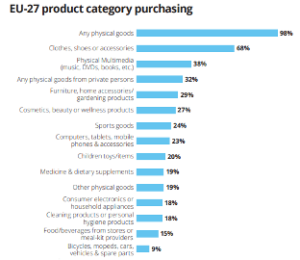Analysis and optimization of the assortment – strategies, tools [complete guide]
- 12 September 2022
There are many elements that determine your store’s success. One of them is your assortment. Depending on what you have in your offer, you attract a specific target audience and get particular results. In this article, we will show you how to optimize your assortment so that it helps you achieve your business goals and grow your e-commerce business.
This means that the way to optimize your assortment starts with in-depth research. You need to know what your store is about and what your purpose is.
Analyze your current assortment and store
For starters, you need to find answers to several important questions. What is your industry (industries)? Who is your customer? What do they need? What products are they looking for? Can they find these products in your store?
Let’s use a quick example; if you want to start an online store for gamers, you need to have all the products they might be interested in, not just the obvious ones. Gaming chairs are a good example – they are not strictly gaming products, but gamers are usually vitally interested in buying them as well. So, does your store offer everything your customers need?
To find a satisfying answer to that question, you have to analyze two elements:
- Your target audience
- Your competition
Use analytics tools like Google Analytics to find out what products your customers are interested in. Check what product categories and what products they browse. Next, you can compare your findings with the second point, which is based on analyzing the competition. Take a look at their websites and product categories – are there any products you don’t have in your assortment? Perhaps it’s worth thinking about adding them to your offer.
On the other hand, you can’t go overboard with that. You shouldn’t add random products to your offer just because “they might be interesting” to your customers. This way, you can sell anything, including products from totally different categories. Such a strategy can work (that’s what large marketplaces like Amazon do), but it’s extremely difficult to pursue and expensive. You should rather concentrate on your niches and improve your offer within them. Don’t sell gaming laptops and garden hoses at the same time.
Opt for an inventory management software
The next step is based on implementing inventory/warehouse management software. Such a platform informs you about what happens with your assortment. Typically, such tools send notifications on low stocks, the number of orders, the most popular product categories, etc. This way, you know how many products to order and of what sort.
Additionally, with an accurate assortment data, you can think of new ways of improving your offer. For instance, if your inventory management software shows that customers purchase many different colors and sizes of a particular product, it is a clear sign to broaden your offer and maybe introduce even more color versions.
If you’re looking for proven tools to manage your assortment and warehouse, take a look at these platforms:
ASSORTMENT PLANNING
- Airtable
- Analyse2
- Retalon
- Aptos Merchandising
WAREHOUSE MANAGEMENT SYSTEMS
- Sortly
- 3PL Warehouse Manager
- Logiwa
- Infor WMS
Lastly, inventory management software helps you make sure that all the popular products are always available in your inventory. These tools frequently help you lower order mix-ups and delays in delivery, too.
Always analyze your customers’ behavior and market trends
Let’s elaborate on the first point on our list. Running an online store means being on a constant lookout. You should know everything there is to know about your customers and their habits. Analyze their behavior on your website and social media profiles – what products are they most interested in? When are they ordering them, and how often? What products are they asking about or searching for? Are there any returns/complaints?
The search engine can be a tremendous source of new ideas on what items/categories/brands to introduce in your offer. If you see that there is a specific brand that’s frequently searched on your website, but you don’t have it in your offer, you should do whatever you can to start offering their products as quickly as possible.
Concentrate on the products that are in demand and eliminate products that aren’t ordered or frequently returned (this way, you can avoid a serious problem which is called dead stock). Moreover, see what products are frequently ordered together. It’s a good starting point for creating product bundles that also can give your inventory a boost.
It’s the same story as market trends. Surely you can find some reports on white papers on what’s going on in your niche. For example, some time ago, we published a report on trends in the electronics and household appliances market. Look for similar publications in your market and country. You can also read general e-commerce reports. Thanks to them, you can understand general customer expectations, e.g., regarding online payments and shipping. That’s also an important part of your online offer!

Analyze these documents, as well as market news, to see what you can improve about your store and its assortment. If there are new products in the specific market, don’t hesitate to introduce them to your offer. Usually, people love novelties and are keen to test them (that’s true, especially with so-called early adopters – people who are eager to give new products a shot).
Take seasonality into account
Many products are popular during just a specific time of the year. For example, not many people will be interested in purchasing winter tires in the middle of the summer. Analyze how many items in your inventory are seasonal products and try to think of a different strategy for them. For example, you can think of attractive promotions and discounts for products that aren’t popular during a specific time of year. It’s also a good idea to sell some of the older products and make space for the new ones.

On the other hand, if there is a high season for specific products, do whatever you can to promote them and distinguish them on your website so that everyone who opens it can easily check your current inventory.
Provide users with sufficient information
The last element on Kepner’s list revolves around information. In e-commerce, this primarily refers to product descriptions and photos. Are your product tabs exhaustive and encouraging? Do they comprise all the relevant information? Are pictures of high quality? Do they show all the product details?
Furthermore, don’t just copy-paste information from the manufacturer’s website! Instead, try adding something more; explain why a given product is a good choice, and show its benefits and interesting features. You can also think about adding customer reviews to your product tabs. This way, customers see that you offer real, in-depth information about your products, which is always a good thing.
Don’t forget about the prices!
Prices are also immensely important when it comes to the attractiveness of your inventory. You can have all the best products in the world, but if you’re selling them at the wrong prices, you won’t make much money. That’s true, especially in the e-commerce world, where people use price comparison engines and marketplaces to find the best (cheapest) offer for a given item.
That’s where our role begins. Here at Dealavo, we help online stores analyze and maintain optimal prices for the products they offer. Our support is twofold:
First off, we help you monitor prices online, especially when it comes to your competition.
And secondly, thanks to our dynamic pricing solution, you can automate the pricing strategy in your store. Our algorithms use AI to learn, set, and maintain optimal prices according to your requirements and current market conditions. Here’s a quick example of how our platform works:

In this example, the difference between the fifth and first offers is just 2.01 EUR. Changing the price by 2.01 EUR probably won’t harm your income, but it will give you much better exposure so that you can sell more products.
That’s how dynamic pricing works – our algorithms continually analyze what’s happening in the market and adjust your prices to their findings so that your offer can maintain profitability and good visibility.
Summary
If you want to succeed online, you have to tick several boxes. Many of them are related to what you offer and for what prices. Analyze your offer and inventory, check your prices, and compare all that to your competitors.
Additionally, never stop analyzing your customers and their needs and expectations. Only this way will you manage to stay competitive in this dynamic and difficult market.